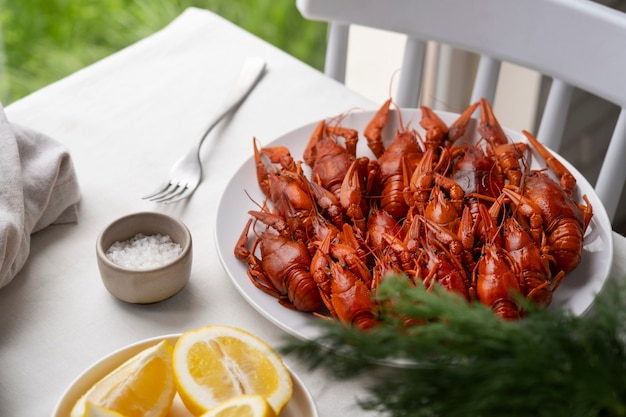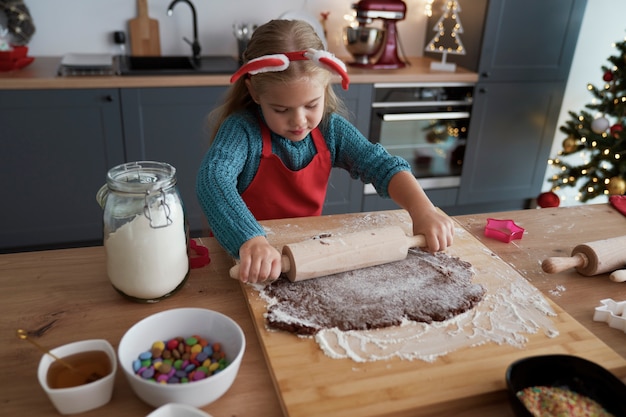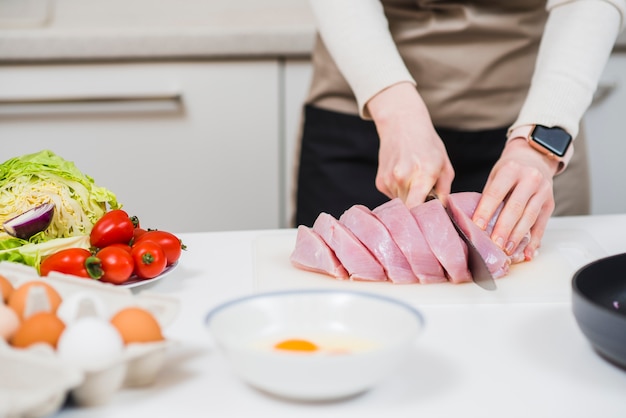Let's be honest, there's nothing quite like a rack of baby back ribs, slow-cooked to perfection, falling off the bone, and glistening with a delicious barbecue sauce. It’s the ultimate comfort food, the perfect centerpiece for any backyard barbecue or family gathering. But achieving that tender, juicy, smoky magic can sometimes feel like a culinary mystery. I've been on a lifelong quest to perfect my rib-cooking skills, and I'm here to share my secrets, my triumphs, and the lessons I've learned along the way. Get ready to embark on a rib-roasting adventure!
(Part 1) The Allure of baby back ribs

There's a reason why baby back ribs have captured hearts and stomachs for generations. They're not just delicious, they're an experience. The aroma of smoking ribs fills the air with a primal comfort, hinting at the feast to come. I remember the first time I really nailed a rack of ribs. It was a hot summer day, my friends were over, and the air buzzed with laughter and conversation. The sight of those glistening ribs, piled high on a platter, was met with gasps of delight. As we dug in, the rich smoky flavors danced on our tongues, and I knew I had achieved something special.
The Anatomy of a Rib: Understanding the Ingredient
Before we get into the nitty-gritty of cooking, let's understand what we're working with. Baby back ribs, sometimes called "spare ribs," come from the loin area of the pig. They're known for their delicate, meaty texture and that beautiful marbling of fat that makes them so incredibly juicy. The name "baby back" is a bit of a misnomer, as they're actually a bit larger than spare ribs.
What Makes a Great Rib: The Quest for Perfection
The magic of a great rib lies in the balance: tender, succulent meat that melts in your mouth, a flavorful, slightly crispy bark, and those smoky, savory flavors that sing on your palate. Imagine the satisfying crackle of the bark as you bite in, followed by the melting tenderness of the meat, all while the smoky, savory flavors explode on your palate. It's a symphony of textures and tastes that makes every bite a culinary adventure.
(Part 2) Choosing Your Ribs: The Foundation of Flavor

The journey to perfect ribs starts with selecting the right ingredients. Just like with any great dish, the quality of your ingredients makes all the difference. Here's what to look for when you're choosing your ribs:
Freshness is Key: Avoid the Stale Stuff
Always opt for fresh ribs. They should be brightly colored, with a fresh, meaty scent. Avoid ribs that look dry or have any discoloration. A good butcher can usually tell you how fresh the ribs are and even recommend some of their favorites.
Size Matters: Feeding the Crowd
For a standard gathering of 3-4 people, a full rack of ribs (usually about 1.5 - 2 lbs) should be plenty. You can also find half racks, which are perfect for smaller groups. If you're cooking for a crowd, get several racks, because let's face it, ribs are always a crowd-pleaser.
The Membrane Mystery: Uncovering the Secret
Here's a crucial detail that many people overlook: there's a thin membrane on the back of the ribs that can make them tough. It's like a little culinary barrier preventing all those amazing flavors from penetrating the meat. You absolutely need to remove this membrane before cooking! You can do this by using a sharp knife or, my personal favorite trick, by simply sliding your finger underneath and pulling it off. It’s a bit messy, but it's worth it for that melt-in-your-mouth tenderness.
(Part 3) Prepping Your Ribs: Setting the Stage for Flavor

Once you've got your perfect ribs, it's time to get them ready for their starring role. This is where the fun starts! Get ready to spice things up.
Seasoning Your Ribs: A Symphony of Spices
This is where you can really get creative. The possibilities are endless, but here are a few classic seasonings that are sure to impress:
- dry rub: This is a simple mix of spices that you rub directly onto the ribs. It's like a spice hug that infuses the meat with flavor. A classic dry rub might include salt, pepper, paprika, garlic powder, and onion powder. You can also add a touch of brown sugar for a hint of sweetness.
- Wet Rub: This is a blend of spices and liquids, like mustard, honey, or vinegar. It's a more intense flavor infusion, and it helps to create a delicious, sticky glaze.
Personally, I'm a fan of a simple dry rub of salt, pepper, paprika, and a touch of brown sugar. It creates a beautiful bark and balances the savory flavors. But feel free to experiment and create your own signature rub – that’s part of the fun!
The Wrap Technique: Unlocking Tenderness
This is a game-changer, a secret weapon for achieving ultimate tenderness. Wrapping your ribs during the cooking process traps moisture and steam, creating that melt-in-your-mouth texture that we all crave. Here's how it works:
- Aluminum Foil: Wrap the ribs tightly in aluminum foil, making sure the seams are sealed. This is like creating a mini steam bath for your ribs.
- Parchment Paper: For a slightly more delicate approach, use parchment paper. This creates a barrier between the ribs and the foil, preventing them from sticking.
I usually wrap the ribs after about 2 hours of cooking, but the timing depends on your preferred level of tenderness and the cooking method you choose.
(Part 4) Cooking Methods: The Slow and Steady Approach
There are a few classic methods for cooking ribs, each with its own unique personality and advantages. Here are the two main contenders:
Low and Slow in the Oven: A Simple, Classic Method
This is a foolproof method, perfect for beginners and anyone who wants a consistent, controlled heat. The oven provides a gentle warmth that slowly breaks down the collagen in the ribs, resulting in incredibly tender meat. It's like a culinary spa treatment for your ribs.
- Preheat your oven to 300 degrees F (150 degrees C).
- Place the ribs on a baking sheet lined with foil.
- Bake for 2-3 hours, or until the meat is tender.
This method is great for achieving that classic, smoky flavor, even without a smoker.
Smokin' Hot on the Grill: Authentic BBQ Flavor
For a truly authentic barbecue experience, there's nothing quite like smoking your ribs. The wood smoke infuses the ribs with a rich, smoky flavor that's simply irresistible. It's like adding a layer of magic to your culinary creation.
- Light your smoker and maintain a temperature of 225-250 degrees F (107-121 degrees C).
- Place the ribs on the smoker, making sure there's enough space between them for even cooking.
- Smoke for 3-4 hours, or until the meat is tender.
Smoking your ribs takes a little more time and patience, but the results are worth it. It's a labor of love that's rewarded with a truly unique flavor profile.
(Part 5) Checking for Doneness: The Rib Test
Knowing when your ribs are done is crucial. You want them fall-off-the-bone tender, but not dry. Here are a few tricks for testing doneness:
The Bend Test: A Simple and Effective Test
This is a simple and effective test. Gently lift one of the ribs and try to bend it. If it bends easily without breaking, it's ready. It should feel like a piece of soft, yielding leather.
The Probe Test: For Precision and Accuracy
Insert a meat thermometer into the thickest part of the rib. It should register an internal temperature of at least 190 degrees F (88 degrees C). This ensures that the meat is cooked through and safe to eat.
The Look Test: Visual Cues for Doneness
As the ribs cook, they'll start to shrink and the meat will pull back from the bone. When the meat is fully cooked, it will have a slightly darkened, glazed appearance. You'll see a beautiful color transformation that signals the ribs are ready for the final touch.
(Part 6) Finishing Touches: Sauce It Up!
You've achieved that perfect tenderness, now it's time to add the final touch – the sauce! There are countless barbecue sauces out there, each with its own unique personality and flavor profile. Here are a few favorites that will satisfy any taste bud.
Sweet and Smoky: A Classic BBQ Flavor
This classic sauce is a perfect balance of sweetness and smokiness. Look for sauces with a combination of brown sugar, molasses, tomato paste, and smoked paprika. It’s the kind of sauce that evokes memories of backyard barbecues and summer evenings.
Tangy and Spicy: A Bold, Flavorful Kick
If you prefer a bit of a kick, go for a sauce with vinegar, chili powder, and cayenne pepper. This sauce adds a bright, tangy flavor with a touch of heat. It's a sauce that's not afraid to make a statement.
Vinegar-Based: A Lighter, More Savory Option
This type of sauce is lighter and more savory, with a hint of acidity. It's perfect for those who prefer a less sweet flavor. It allows the natural flavors of the ribs to shine through.
I usually brush the sauce on the ribs in the last 30 minutes of cooking. This helps to create a nice, sticky glaze without overcooking the meat. It's a delicate dance between flavor and texture.
(Part 7) Serving Your Rib Masterpiece: The Grand Finale
Finally, the moment of truth has arrived! You've invested your time and effort, and now it's time to enjoy the fruits of your labor.
Presentation Matters: Making Your Ribs Shine
Don't underestimate the power of presentation. A beautiful platter of ribs, adorned with a sprinkle of fresh herbs, a squeeze of lemon, and a side of your favorite barbecue sides, instantly elevates the dining experience. It’s about making a statement and setting the tone for the meal.
Savor Every Bite: Appreciating the culinary journey
Now, this is the most important step. Take your time, savor every bite, and appreciate the juicy, tender, and flavorful creation that you've made. Let the flavors linger on your tongue, and remember the journey that brought you to this moment.
(Part 8) FAQs: Your Rib-Related Questions Answered
I've compiled a list of frequently asked questions about cooking ribs. Let's tackle those burning questions:
1. Can I cook ribs in the instant pot?
You certainly can! While not the traditional method, the Instant Pot can achieve impressive tenderness. Cook on high pressure for 60-90 minutes, depending on the size of the ribs. Release the pressure naturally for 15 minutes before quick-releasing. This method is great for busy weeknights when you need a quick and easy meal. It's a modern twist on a classic dish.
2. How long do ribs take to cook in the oven?
The cooking time for oven-baked ribs varies depending on the size of the rack, the oven temperature, and the desired level of tenderness. Generally, it takes 2-3 hours at 300 degrees F (150 degrees C) for a full rack of ribs. You can also wrap the ribs in foil for the last hour of cooking to enhance tenderness. It's a process that requires patience and attention, but the results are worth it.
3. How do I make sure my ribs don't dry out?
The key to preventing dry ribs is to cook them low and slow. Use a low oven temperature or a smoker and keep a close eye on the ribs, checking for doneness using the methods mentioned earlier. Wrapping the ribs in foil during the last hour of cooking also helps to retain moisture. It's all about finding that perfect balance between heat and time.
4. What's the best way to reheat ribs?
The best way to reheat ribs is to wrap them tightly in aluminum foil and bake them in a preheated oven at 250 degrees F (121 degrees C) for about 30 minutes. This helps to retain moisture and prevent the ribs from drying out. It's a great way to enjoy your ribs the next day, without sacrificing any of their deliciousness.
5. Can I make ribs ahead of time?
Absolutely! You can cook the ribs ahead of time and reheat them. It's actually a great way to save time. Simply cook the ribs according to your preferred method and then let them cool completely. Then, wrap the ribs tightly in aluminum foil and refrigerate for up to 3 days. When ready to serve, reheat the ribs in the oven or smoker as described above. It’s perfect for planning ahead for a busy week or a special event.
(Part 9) Conclusion: A Celebration of Rib-Cooking
So there you have it, my ultimate guide to achieving those perfect, melt-in-your-mouth baby back ribs. It's a journey that combines technique, patience, and a dash of culinary creativity. It's about embracing the process, learning from your experiences, and finding your own unique style. Whether you're a seasoned grill master or a kitchen novice, remember that cooking ribs is about more than just the food. It's about creating memories, sharing laughter, and celebrating the simple joy of a delicious meal. Now go forth, my friends, and conquer the art of rib-cooking!
Everyone is watching

Corn on the Cob: The Ultimate Guide to Perfectly Cooked Ears
Healthy MealsAh, corn on the cob. Just the name evokes images of sunny days, barbecues, and that sweet, juicy flavour that ...

Scallops: The Ultimate Guide to Perfect Cooking
Healthy MealsAh, scallops. Those delicate, sweet, and utterly delicious morsels of the sea. They hold a special place in my...

Spaghetti Squash: The Ultimate Guide to Cooking and Serving
Healthy MealsRemember that time you saw spaghetti squash at the supermarket, looking all bumpy and strange, and thought, "W...

Salmon Cooking Times: Perfect Guide for Every Recipe
Healthy MealsLet me tell you, cooking salmon is an art form. It's all about getting that perfect balance: juicy and tender,...

Ham Cooking Time: How Long to Bake, Smoke, or Boil a Delicious Ham
Healthy MealsAh, ham. It's a classic, isn't it? A real crowd-pleaser, especially around holidays. And when done right, it'...
